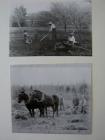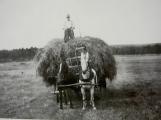1
1) FARMING -The Early Days, North Shore, Nova Scotia, CanadaLate 1870's - early 1900's
North Shore, Nova Scotia, Canada
 Credits:
Credits:North Shore Archives, Creamery Square Heritage Centre (CSHC)
2
FarmingBefore horses and oxen were readily available, the work was done by hand, using a shovel, hoe, potato and hay forks, hand rake, plough, scythe, spike tooth harrow, and eventually an oxcart. The 1830's saw most farmers with a horse or two and an ox, but farming was still labour intensive with little in the way of surplus crops to sell. It was subsistence farming, with all members of the family helping. Any extras, such as wheat, buckwheat, oats and potatoes, meant a week of hard travelling to get a heavy load to the Halifax market. The farmer returned with vital supplies, but the journey might only take place twice a year. Some farmers packed tubs of butter into saddlebags and took them to Halifax on horseback.
Sometimes hired help would be available, working for board and lodging, as there was little surplus money to hand out.
The plough used here to break the soil differed little from those used in medieval times; horses or oxen were used. In the above picture, the family is digging for potatoes, and even the youngest were involved.
Grain sown was mostly oats and buckwheat; the latter could be eaten as well as ploughed back in to the soil to fertilize it. Some wheat and rye were grown but originally all grains had to be hand hauled to the few existing grist mills to be ground. As the years went by more grist mills were built, which with a horse and wagon made one task easier for the famer.
During the early 1800's, a Scottish lawyer, John Young, writing under the pen name 'Agricola', produced newspaper articles on how to improve agricultural practice, and as a result many agriculral societies sprang up. By means of fairs, exhibitions, and competitions, information spread and farming benefited greatly, eventually leading to the co-operative movement and 'co-op' stores.
3
Farming in the late 1800's, North Shore, Nova Scotia, CanadaCirca 1890
North Shore, Nova Scotia, Canada
 Credits:
Credits:North Shore Archives, CSHC
4
Hay was vital to the farmer once he had livestock. His horse needed hay as did his few cows which had to be kept in a barn over winter. Haying was a laborious task, requiring hand raking originally, piling it on to wagons and then getting it under cover. Surplus would be made into ricks, or sold to add to the income. If he was lucky a second crop might be possible, depending on the maritime weather.Dairy cows were gradually introduced, enabling the wife and daughters to make butter, some of which could be sold or exchanged. Until the arrival of milking machines, the hand churning was a slow process. Dog tread-mill churns helped the busy wife and freed her to do other chores.
Keeping the cream or butter fresh, without refrigeration, was a problem - the wells became useful places to hang containers of milk, cream or butter.
Winter saw the farmer move to the woodlot; having cleared half his land, the remainder, left in wood, gave him an income, provided he could get the wood to a roadside for collection. Farmers shared saws and helped each other with the major tasks required of farming.
In a good year a farmer might have surplus hay to sell, but extra eggs or butter were bartered or later taken to the local store for sale. Thus farming was an industrious occupation, but not an industry until the coming of the railway, better roads and eventually motors which enabled the transport of products. In the 1920's the building of the Creamery in Tatamagouche encouraged farmers to keep dairy cattle, supplying the cream for the production of butter.
Advances were made and there is a record in a copy of the 1883 Pictou News of a 'draining machine'. It was demonstrated on Mr Kitchin's Stock Farm. Made of cast steel, it consisted of a large wheel which worked on the principle of a dredging machine, set between two others wheels some 7 feet (2 meters) apart, and drawn by two strong horses. By means of certain levers, and from his seat the manager could control the machine and remove some 3 inches (7.5 cms) of soil each time it passed up and down. This continued until a depth of some 3 feet (1 meter) was reached. The newspaper thought it was destined to work a revolution in farming!